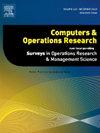Maximum capture location problem with random utilities and overflow penalties
IF 4.3
2区 工程技术
Q2 COMPUTER SCIENCE, INTERDISCIPLINARY APPLICATIONS
引用次数: 0
Abstract
This paper extends the maximum capture location problem with random utilities by incorporating the facility capacity and introducing penalties for overflows into the objective function. We propose a method that combines the key features of two state-of-the-art approaches for the uncapacitated case, which are adapted to solve the problem at hand. The first approach is a linear reformulation that extends the best-known linearization in the literature, which is based on variable substitution. The second approach is a reformulation that incorporates outer-approximation cuts and enhanced submodular cuts, solving the problem via a branch-and-cut approach. We tested the performance of the three approaches on several instances and show that the combined method outperforms each of the preceding techniques. The optimal location patterns of the model are also analysed, and it is found that considering the overflow and overflow penalties in the objective function affects the location decisions. The resulting optimal locations align more closely with practical scenarios.
随机实用程序和溢出惩罚的最大捕获位置问题
本文通过在目标函数中引入设施容量和溢出惩罚,扩展了具有随机效用的最大捕获位置问题。我们提出了一种方法,结合了两种最先进的方法的关键特征,用于无行为能力的情况下,这是适合解决手头的问题。第一种方法是线性重构,扩展了文献中最著名的线性化,它是基于变量替换的。第二种方法是将外部近似切割和增强的子模块切割结合起来,通过分支切割方法解决问题。我们在几个实例上测试了这三种方法的性能,并表明组合方法优于前面的每一种技术。分析了模型的最优选址模式,发现在目标函数中考虑溢出惩罚和溢出惩罚会影响选址决策。最终的最佳位置与实际场景更加接近。
本文章由计算机程序翻译,如有差异,请以英文原文为准。
求助全文
约1分钟内获得全文
求助全文
来源期刊

Computers & Operations Research
工程技术-工程:工业
CiteScore
8.60
自引率
8.70%
发文量
292
审稿时长
8.5 months
期刊介绍:
Operations research and computers meet in a large number of scientific fields, many of which are of vital current concern to our troubled society. These include, among others, ecology, transportation, safety, reliability, urban planning, economics, inventory control, investment strategy and logistics (including reverse logistics). Computers & Operations Research provides an international forum for the application of computers and operations research techniques to problems in these and related fields.
 求助内容:
求助内容: 应助结果提醒方式:
应助结果提醒方式:


